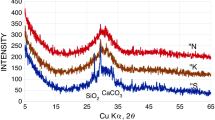Abstract
A number of samples from the pre-burning zone of a wet-process cement rotary kiln were examined by combined DTA/TG and XRD for estimation of spurrite (2Ca2SiO4·CaCO3). It was found that decarbonation temperatures of spurrite range from 1130 to 1190 K and they are 45 to 75 K higher than that of calcite occurring in the same sample. In the TG curves calcite and spurrite can be easily distinguished and accordingly both can be estimated from the same TG scan. Combined DTA/TG, supplemented by XRD, is a very effective method for qualitative and quantitative estimation of spurrite in cement rotary kiln materials.
Zusammenfassung
Unter kombinierter Anwendung von DTA/TG und Röntgendiffraktionsverfahren wurde eine Anzahl Proben aus einem Vorkalzinator eines Drehrohrofens zur Zementherstellung nach dem Naßverfahren auf Spurrit (2Ca2SiO4·CaCO3) untersucht. Es wurde festgestellt, daß die Temperatur für das Austreiben von CO2 bei Spurrit zwischen 1130 und 1190 K und somit um 45–75 °C höher als bei in derselben Probe vorliegenden Kalzit liegt. Aufgrund der TG-Kurven können Kalzit und Spurrit leicht voneinander unterschieden und demzufolge mit einem einzigen TG-Scan bestimmt werden. Kombinierte DTA/TG, ergänzt durch Röntgendiffraktionsverfahren ist eine sehr leistungsstarke Methode zur qualitativen und quantitativen Bestimmung von Spurrit in Stoffen aus Zementdrehrohröfen.
Резюме
С целью установления спуррита (2Ca2SiO4 · CaCO3), комбинированным мет одом ДТА/ТГ и диффракцией р ентгеновских лучей б ыл исследован ряд проб, в зятых из зоны предобжига вращающе йся цементной печи, ра ботающей по мокрому способу. Найд ено, что температуры декарбо низации спуррита нах одятся в области температур 1130– 1190 К, что на 46–75 К выше чем для кальц ита, находящегося в то м же самом образце. Кривые ТГ для кальцита и спуррита могут быть легко разделены и поэ тому обе кривые могут быть уст ановлены из одного и того же ТГ изм ерения. Комбинирован ный метод ДТА/ТГ, дополненный ре нтгенодиффракционн ым, является очень эффек тивным методом качес твенного и количественного определения спуррит а в материалах вращаю щейся цементной печи.
Similar content being viewed by others
References
B. Courtault, CERILH Technical Pub., 140 (1963) 1.
F. Becker and W. Schraml, Cement and Lime Manuf., 42 (1969) 91.
Hung Chen, Proc. VII Intern. Conf., Thermal Analysis, 2 (1982) 1303.
A. M. Herr, W. Henning and H. Scholze, Tonind-Stg., 92 (1968) 491.
F. Steuerwald, P. Hackenberg and H. Scholze, Zement-Kalk-Gips, 23 (1970) 579.
F. P. Glasser, Cement Conc. Res., 3 (1973) 23.
H. M. Sylla, Zement-Kalk-Gips, 27 (1974) 499.
W. Weisweiler and W. Dallibor, Zement-Kalk-Gips, 37 (1984) 553.
H. Midgley, Cem. Conc. Res., 9 (1979) 778.
A. Janko, Proc. 7th Intern. Congr. on Cement Microscopy, Ft. Worth, Texas 1984, p. 56.
A. Gross, Israel J. Chem., 9 (1971) 601.
Author information
Authors and Affiliations
Additional information
The authors are very grateful to Mr. A. H. Dalmia, president, M/s. Orissa Cement Limited, Rajgangpur for allowing to collect the samples during the stoppage of the kiln and also for his permission to publish the paper.
Rights and permissions
About this article
Cite this article
Goswami, G., Padhy, B.P. & Panda, J.D. Thermal analysis of spurrite from a rotary cement kiln. Journal of Thermal Analysis 35, 1129–1136 (1989). https://doi.org/10.1007/BF01913030
Issue Date:
DOI: https://doi.org/10.1007/BF01913030




